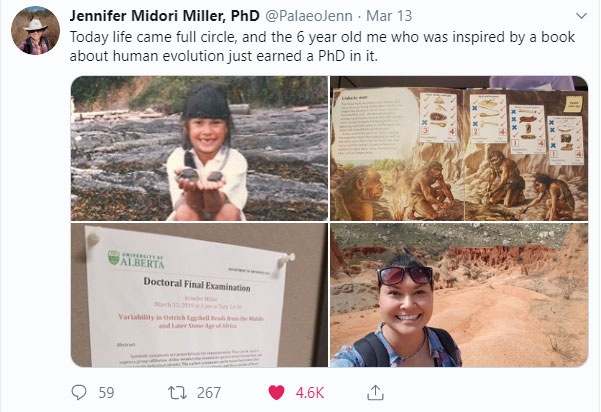
The day that Jennifer Miller received her PhD in Anthropology, she was struck by a memory of herself as a young girl when, at the age of six, she had been given a book about human evolution. The ideas in that book would shape the direction of her life, leading to a career in archaeology.
The book was Time Traveller (Young Explorers) by John Satchwell and Chris Stringer.
Years later, Miller would meet Stringer - a renowned physical anthropologist and an enduring inspiration throughout her academic career. It was only recently, however, that she realized that he had been the consultant on the book.
"Time Traveller takes the reader back in time to key events on the path to humanity such as the invention of stone tools, the origin of music, and the demise of Neanderthals," she says. "It was cool to imagine what it would have been like to live in those times."
Her imagination became a reality when she began her archaeological studies, first at Simon Fraser University in BC, and then in the Department of Anthropology at the University of Alberta, where she obtained her master's and doctoral degrees under the supervision of Pamela Willoughby.
The self-described "Palaeolithic bead lover" looks at variability in ostrich eggshell beads from the Middle and Later Stone Age of Africa. These tiny ornamental objects (1 cm in diameter) were made by human hands approximately 50,000 years ago. By examining the subtle differences in the manufacture, form, and use-wear in these artifacts, Miller is able to glean important information about our stone-age ancestors.
"They are not only physical evidence of ancient technology, they also afford a glimpse into the minds of Palaeolithic people," she says.
Unlike animals, humans create symbols for communication, explains Miller, which convey information about our beliefs, social standing, and other factors. For the first million years of evolution, however, our ancestors were focused on immediate survival like food, shelter and protection. According to Miller, it's not until 50,000-75,000 years ago that we see investments in aesthetic pursuits, like jewelry.
"This development coincides with the spread of modern humans out of Africa where we thrive and conquer every environment," she says. "Meanwhile, other types of hominin (like Neanderthals) are unable to cope with environmental changes and fade out of existence. So the evolution of symbolic ornaments seems linked in some way to our species' success, perhaps marking an important intellectual or social change."

Jennifer Miller on top of Magubike Rockshelter in Tanzania (PHOTO: Jennifer Miller)
Miller says the emergence of beads in the Palaeolithic is a tangible record of the increasing complexity of social interactions and the rising importance of symbolic communication - core issues in the study of human evolution.
"Archaeology is kind of like investigating a mystery, and human evolution examines the biggest mystery of all: Who are we? How did we get here? Why do we do the things we do? The more I discover, the more questions come up, and the more thrilling it all becomes."
Just as those beads speak to her across millennia, so too does the memory of herself as a young girl, holding a book that would inspire a life-long journey.
In September, Miller will begin a postdoctoral fellowship at the Max Planck Institute for the Science of Human History, working at a site on the Kenyan coast with a long archaeological sequence and "some really cool beads".
"People might think it would be dull to look at so many beads (I've studied somewhere over 3,000 of them now) but it never gets old for me," she says. "I think about the person who made and wore it, whether it was traded, and how it might've ended up in the archaeological record. The people who made them couldn't have known that they would end up in the hands of a Canadian thousands of years in the future, but I sure think about them a lot."
Jennifer Midori Miller received her PhD in Anthropology on June 13, 2019. Her PhD thesis is entitled: Variability in Ostrich Eggshell Beads from the Middle and Later Stone Age of Africa
Read more about the study of Anthropology here.